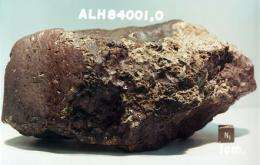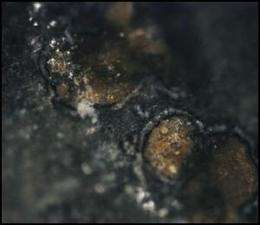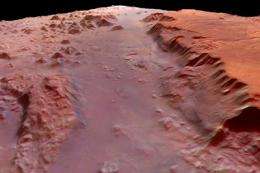Mars meteorite controversy continues

The most illustrious meteorite in history continues to inspire heated debate. Does it carry microbial fossils from Mars or are its strange features just the product of some unique geochemistry? After almost 20 years, dueling papers are still coming out, and the opposing parties are no closer to a resolution.
Most scientists agree that the meteorite ALH84001 is the oldest meteorite ever found to have come from Mars.
"The meteorite is so old that if Martian life existed back then, it probably floated by the rock at some point," says Timothy Swindle of the University of Arizona. "But did it leave any record?"
In 1996, one research group claimed yes, sending shock waves through the scientific community and beyond. President Bill Clinton made a special address on the apparent discovery, and the media widely broadcasted the scientists' images of what appeared to be dead "bug" remains from the rock. Had we finally met our neighbors?
The iconic meteorite became the grist for many imaginations. The TV show The X-files depicted an ALH84001 look-a-like with live bugs in it, and a Dan Brown novel imagined a conspiracy to cover-up extraterrestrial evidence from a space rock.
Biopic of a falling star
The meteorite made its debut in 1984, when it was picked up by a geologist team riding snowmobiles through the Allan Hills region of Antarctica. It took 10 years for researchers to realize this 4-pound specimen likely came from Mars.
The general consensus now is that the original rock formed 4 billion years ago on Mars. It was eventually catapulted into space by an impact and wandered the solar system for millions of years before landing on Earth 13,000 years ago.
Over 50 other meteorites have been identified as coming from Mars, but ALH84001 is by far the oldest, with the next in age being just 1.3 billion years old.
"That alone makes ALH84001 a very important sample," says Allan Treiman of the Lunar and Planetary Institute. "It's our only hope to understand what Mars was like at this time period."
The first thing that struck researchers examining the meteorite was the presence of 300-micron-wide carbonate globules that make up 1% of the rock. Dave McKay from NASA's Johnson Space Center and his colleagues determined that the carbonate most likely formed in the presence of water.
Although evidence for a wet ancient Mars has accumulated in the subsequent years, the claim that ALH84001 once sat in water was pretty revolutionary at the time, says Kathie Thomas-Keprta, also from the Johnson Space Center.
Inside the ALH84001 carbonates, McKay spotted odd features that resembled very small worm-like fossils, so he asked Thomas-Keprta to look at them more closely with electron microscopy.

"I kind of thought he was crazy," she says. "I thought I would join the group and straighten them out."
In the end, she helped the team characterize the biomorphic features, as well as unusual grains of the mineral magnetite found in the meteorite. In a 1996 Science paper, these two phenomena – along with the chemical distribution in the globules and the detection of large organic molecules – were taken collectively as signatures of biological activity occurring long ago on Mars.
The storyline unravels
However, skeptics began to pick apart the four lines of evidence presented in the 1996 paper.
Groups of geologists and chemists proposed alternative ways that the carbonate globules and the organic molecules could have formed without the need of Martian microbes.
The supposed fossil shapes were so small they could only have been the remains of hypothetical "nanobacteria." A more plausible explanation, according to other researchers, was that the tiny artifacts are uneven patches in the coating used to prepare the samples for electron microscopy.
That left the magnetite grains as the strongest case for a biologic imprint in ALH84001.
"The focus of the last 10 years has been the magnetite," says Thomas-Keprta.
Microbial compasses

Magnetite (Fe3O4) is a common mineral found on black sandy beaches, in iron-rich sediments and even in interplanetary dust. The majority of this magnetite forms in geologic processes, where many elements mix together and iron often gets replaced with iron-like elements such as magnesium and chromium.
However, the magnetite grains found in the carbonate globules of ALH84001 have very few of these sorts of substitutions.
"I had never seen magnetite as chemically pure as this before," Thomas-Keprta says.
But when she looked through the literature, she realized that chemically pure magnetite is known from biology. So-called magnetotactic bacteria create a chain of magnetite grains to help orient themselves in their search for nutrients. Iron makes for a stronger magnet, so the bacteria are very selective when they form their magnetite compasses. They also build grains of a uniform size (roughly a tenth of a micron) that optimizes the magnetic response.
"The size and purity of the magnetite is controlled by the organism to be the best magnet it could be," Thomas-Keprta says.
In 2001, she and her colleagues showed that many of the same properties in biologically-derived magnetite are reproduced in the grains from ALH84001. The conclusion was that Martian microbes once used magnetite for the same purpose as terrestrial ones do.
Treiman agrees that the ALH84001 magnetite is unlike geologically-produced magnetite found on Earth. "But everything else about this meteorite is unique," he argues. "There comes a point where being unique is not unique."
It's improbable that Martian microbes deposited magnetite grains directly in the rock, so Thomas-Keprta and her colleagues have to argue that the magnetite formed outside of the rock and washed in. They also have to assume that Mars had a much stronger magnetic field in the past so that building an intracellular magnetic compass would be an advantage.
Treiman and others argue that the magnetite could be explained more easily with some sort of shock event that heated the carbonate enough to allow magnetite grains to form. Thomas-Keprta says these abiotic models are fatally flawed. The problem is in the cooling time. If the rock cools too fast, the magnetite ends up full of impurities. Too slow and the surrounding carbonate becomes too uniform.
"They are looking for a single event that can account for all the magnetite," Thomas-Keprta says. "But no natural or laboratory synthesized analogs proposed have yet to reproduce the chemical and physical properties observed in the ALH84001 carbonate-magnetite assemblages."
She and Treiman went head to head at a recent Lunar Planetary Society Conference. Neither side has relented.
"Naysayers are always going to be naysayers," Thomas-Keprta says. "But I hope people on the fence will look at the evidence."
Polling the community

Treiman thinks that the issue is probably settled for most of his colleagues. "I am one of the few holdovers still arguing about it," he says. "I can't move on."
The debate may not be settled anytime soon. Treiman isn't sure how one could ever entirely rule out that Martians might have had a hand in forming ALH84001. "Nature is infinitely complicated," he says. "It is always surprising us."
However, he believes the alternative explanations from geology and chemistry are simpler, since they don't require inventing the whole new science of Martian biology. Scientists are trained to pick the simplest explanation.
An informal poll of more than 100 scientists by Swindle in 1997, right after the first announcement of possible biological relics in ALH84001, showed that most of the community was already hedging their bets. The typical response gave about even odds that Mars once had life but said that there was just a 1-in-5 chance that McKay's group had found the smoking gun.
A few years later, Swindle tried to do the poll again but couldn't get enough respondents to form a representative sample. He thinks most people had made up their mind that ALH84001 did not carry biosignatures from Mars. But that doesn't mean that sifting through the meteorite hasn't been worth it.
"It was good science," he says. "It challenged people to really think about what would count as evidence of life on Mars."
Source: Astrobio.net





















